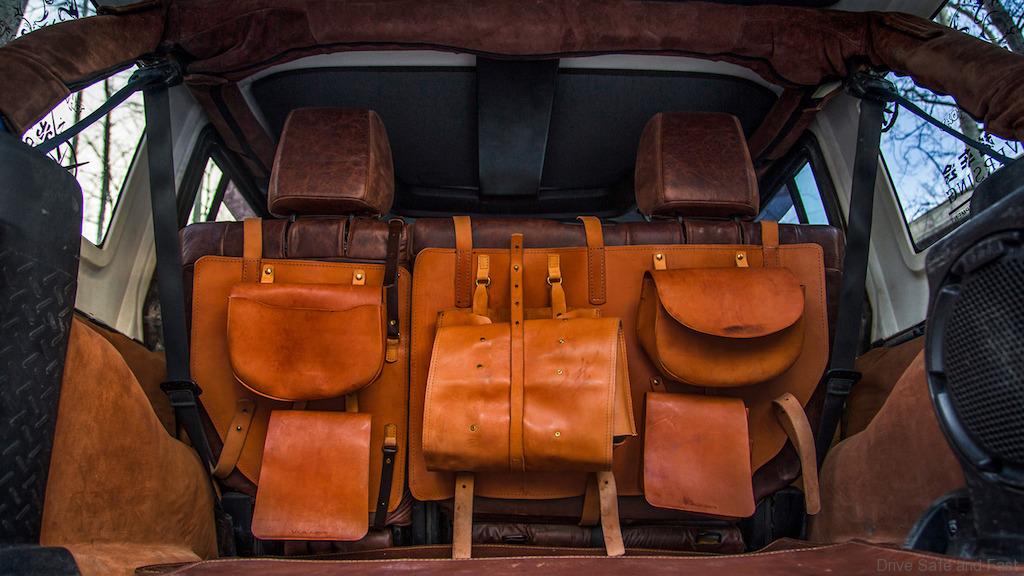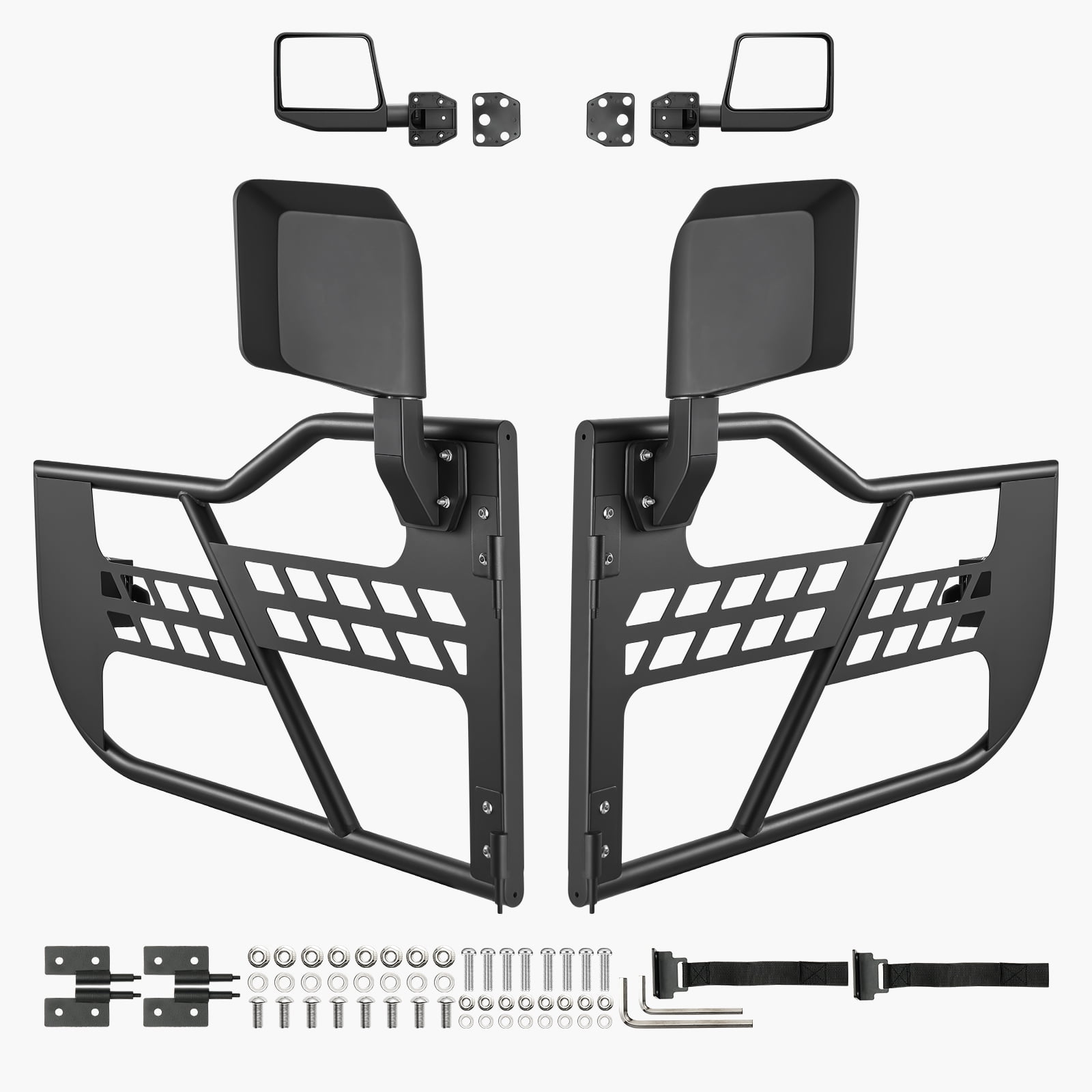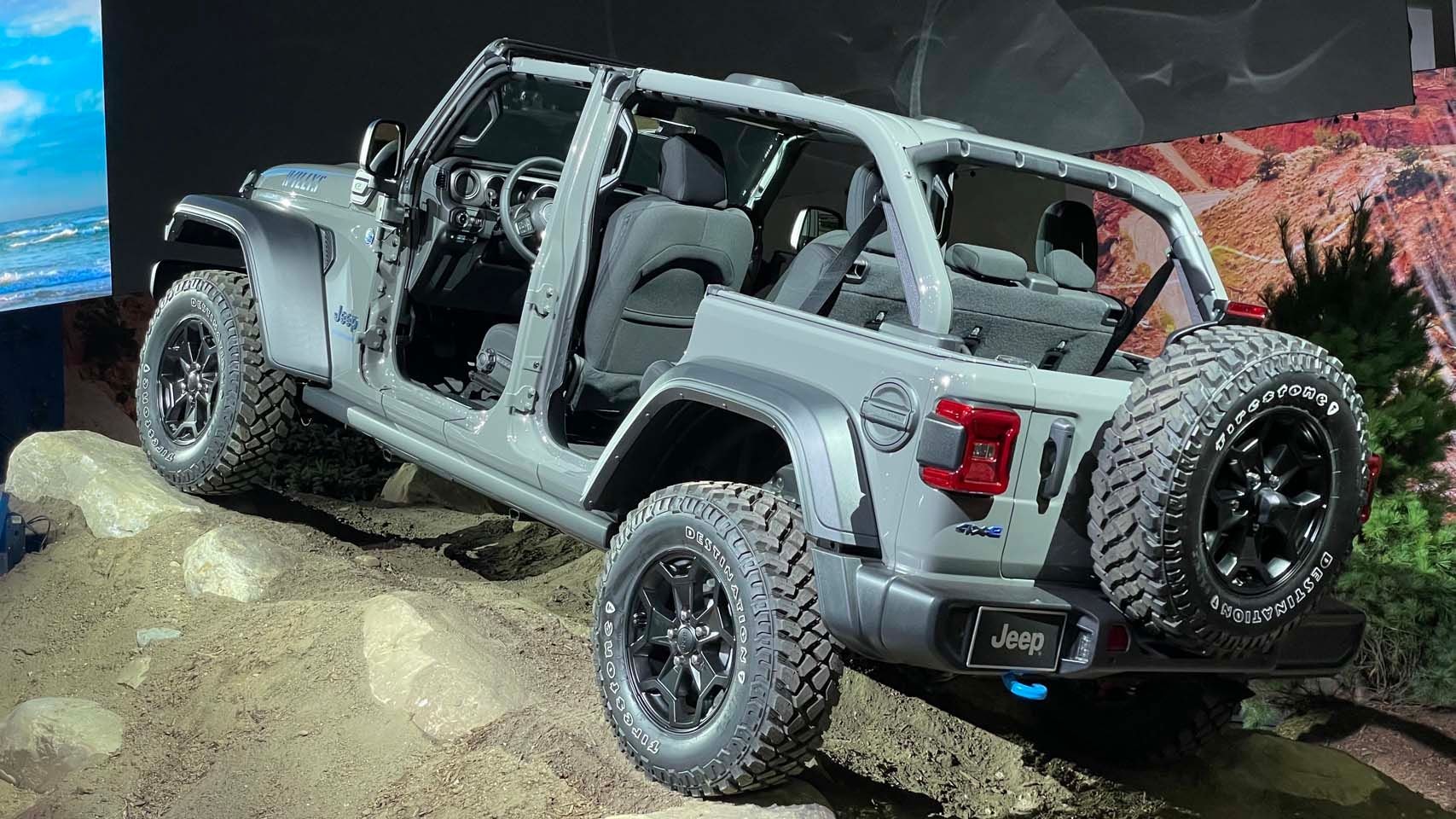Hunting Accessories For Jeep Wrangler: Equipping Your Rig for the Wild
Hunting Accessories For Jeep Wrangler: Equipping Your Rig for the Wild jeeps.truckstrend.com
The Jeep Wrangler has long been an icon of off-road capability and adventure, a vehicle synonymous with exploring the untamed wilderness. For avid hunters, this rugged machine isn’t just a mode of transport; it’s a vital part of their gear, a reliable partner that can navigate challenging terrains to reach remote hunting grounds. However, a stock Jeep Wrangler, while capable, can be significantly enhanced with the right hunting accessories. These specialized additions transform your Wrangler into the ultimate hunting rig, improving safety, efficiency, comfort, and the overall success of your expedition. From traversing muddy trails to securely transporting firearms and game, equipping your Jeep with purpose-built accessories is paramount for any serious hunter.
This comprehensive guide delves into the essential hunting accessories for your Jeep Wrangler, offering insights into their benefits, key considerations for selection, and practical advice to optimize your vehicle for the demands of the hunting season.
Hunting Accessories For Jeep Wrangler: Equipping Your Rig for the Wild
I. Essential Protection & Recovery Gear: Conquering the Unforeseen
When venturing into remote hunting territories, getting stuck or damaging your vehicle is a significant risk. Essential protection and recovery gear are your insurance policy against such misfortunes, ensuring you can get to your spot and, more importantly, get back home safely.
1. Heavy-Duty Bumpers (Front & Rear)
- Why it’s important for hunting: Stock bumpers offer minimal protection against impacts with rocks, trees, or wildlife. Aftermarket steel bumpers provide superior strength, often incorporating mounting points for winches, D-rings for recovery, and auxiliary lights. Front bumpers can also feature brush guards for added grille and headlight protection. Rear bumpers often include tire carriers for oversized spares and additional recovery points.
- Key Features to Look For: Steel construction, winch compatibility, D-ring mounts, integrated light mounts, high-clearance design, compatibility with factory sensors (if applicable).
- Tips: Choose bumpers that match your off-road needs. If you anticipate heavy winching, ensure the bumper is rated for it.

2. Winch & Recovery Kit
- Why it’s important for hunting: A winch is arguably the most critical self-recovery tool. Whether you’re stuck in mud, sand, or snow, a powerful winch can pull your Jeep out of trouble. A comprehensive recovery kit includes essential items like recovery straps, shackles, a snatch block, and gloves, complementing your winch for safe and effective recovery operations.
- Key Features to Look For: Winch capacity (1.5x vehicle GVWR recommended), synthetic rope (lighter, safer) vs. steel cable, IP rating for water resistance, remote control options. Recovery straps should be rated for your vehicle’s weight.
- Tips: Learn how to properly use your winch and recovery gear before you need it. Consider a tree saver strap to protect nature during recovery.

3. Skid Plates
- Why it’s important for hunting: Underbody components like the oil pan, transmission, transfer case, and fuel tank are vulnerable to impacts from rocks and debris on rough trails. Skid plates provide a protective barrier, preventing costly damage that could leave you stranded.
- Key Features to Look For: Durable material (steel or aluminum), full coverage for critical components, easy installation, drainage holes to prevent mud/water buildup.
- Tips: Assess the trails you typically traverse. If they involve rocky terrain, comprehensive skid plate coverage is a wise investment.

4. High-Lift Jack
- Why it’s important for hunting: A high-lift jack is a versatile tool for lifting your vehicle in uneven terrain, changing large tires, or even assisting in recovery operations. It’s far more effective than a standard factory jack for lifted Jeeps or challenging off-road scenarios.
- Key Features to Look For: Sufficient lifting height for your vehicle, robust construction, a wide base for stability, and accessories like a bumper lift attachment or wheel lift.
- Tips: Always use a high-lift jack with extreme caution. Secure your vehicle, wear gloves, and understand its proper operation to prevent accidents.
II. Enhanced Storage & Organization: Maximizing Cargo Efficiency
Hunting trips often require significant gear, from firearms and ammunition to camping equipment, food, and eventually, game. Efficient storage and organization are crucial for accessibility, security, and maximizing space within your Wrangler.
1. Roof Racks & Cargo Baskets
- Why it’s important for hunting: A roof rack significantly expands your cargo capacity, allowing you to carry bulky items like tents, extra fuel cans, recovery boards, or even a deer carcass safely and securely outside the vehicle.
- Key Features to Look For: High weight capacity, durable construction (steel or aluminum), ease of installation, compatibility with various accessories (e.g., light mounts, shovel mounts).
- Tips: Distribute weight evenly on the roof rack. Be mindful of increased vehicle height, especially under low branches or in garages.
2. Interior Cargo Management Systems
- Why it’s important for hunting: Drawer systems, cargo nets, and MOLLE panels help organize smaller gear, keeping it secure and easily accessible. This prevents items from sliding around during off-road travel and ensures you can quickly find what you need.
- Key Features to Look For: Durable materials, customizable compartments, secure locking mechanisms for drawers, vehicle-specific fit.
- Tips: Plan your storage based on the frequency of use. Keep essential items easily reachable, while less-used gear can be stored in deeper compartments.
3. Secure Weapon Transport
- Why it’s important for hunting: Safely and legally transporting firearms is non-negotiable. Dedicated gun cases, mounts, or vault systems ensure weapons are secure, protected from damage, and inaccessible to unauthorized individuals.
- Key Features to Look For: Lockable, padded interior, quick-release mechanisms for mounts, compliance with local firearm transportation laws.
- Tips: Always check local and state laws regarding firearm transport. Ensure the chosen system keeps your firearm protected from dust, water, and impacts.
4. Heavy-Duty Coolers
- Why it’s important for hunting: Beyond keeping drinks cold, a robust cooler is essential for preserving harvested game. High-performance coolers offer superior insulation to maintain low temperatures for extended periods, crucial for meat quality.
- Key Features to Look For: Rotomolded construction, thick insulation, durable latches, drain plug, capacity suitable for your hunting style (e.g., a large cooler for a deer, smaller for birds).
- Tips: Pre-chill your cooler before packing. Use block ice for longer cooling durations. Consider a dedicated game cooler separate from food/drink coolers.
III. Optimized Lighting & Visibility: Navigating the Dark
Hunting often involves early mornings or late evenings, and navigating unlit trails or setting up camp in the dark requires superior illumination beyond factory headlights.
1. Auxiliary Lights (Light Bars, Pod Lights, Spot/Flood Lights)
- Why it’s important for hunting: These lights provide crucial additional illumination for off-road driving in low light conditions, spotting game, or setting up camp. Light bars offer broad coverage, while spot/flood lights provide focused beams for specific tasks.
- Key Features to Look For: High lumen output, durable housing (IP-rated for water/dust resistance), various beam patterns (spot, flood, combo), easy mounting solutions.
- Tips: Consider the type of light needed for different situations. A combination of a wide flood light for general area illumination and a powerful spot beam for long-range visibility is ideal.
2. Specialty Headlights & Fog Lights
- Why it’s important for hunting: Upgrading to LED headlights and fog lights improves visibility, especially in adverse weather conditions like fog, rain, or snow, which are common during hunting seasons. They offer a brighter, clearer beam pattern than traditional halogen lights.
- Key Features to Look For: DOT compliance (for street legality), high lumen output, crisp beam pattern, durable construction, plug-and-play installation.
- Tips: Ensure any aftermarket headlights are properly aimed to avoid blinding oncoming drivers.
IV. Performance & Traction Upgrades: Mastering the Terrain
The Jeep Wrangler’s off-road prowess can be significantly enhanced with upgrades to its tires and suspension, allowing it to tackle more challenging terrain with greater ease and confidence.
1. All-Terrain (A/T) or Mud-Terrain (M/T) Tires
- Why it’s important for hunting: Stock tires are often insufficient for the varied and unpredictable terrain encountered during hunting. A/T tires offer a good balance for highway and off-road use, while M/T tires provide maximum traction in mud, rocks, and loose dirt, crucial for reaching remote hunting spots.
- Key Features to Look For: Aggressive tread pattern, durable sidewalls (puncture resistance), appropriate load rating, size compatibility with your Jeep and any lift.
- Tips: Choose tires based on the predominant terrain you hunt in. M/T tires are louder and wear faster on pavement but excel off-road. A/T tires are a good compromise for mixed use.
2. Lift Kits & Suspension Upgrades
- Why it’s important for hunting: A lift kit increases ground clearance, allowing your Jeep to clear obstacles more easily and accommodate larger, more capable off-road tires. Suspension upgrades improve articulation, ride quality on rough trails, and handle the added weight of accessories and gear.
- Key Features to Look For: Lift height (2-3 inches often ideal for hunting), quality shocks and springs, complete kits that include necessary components for proper geometry correction.
- Tips: Research reputable brands and professional installation. A proper lift ensures optimal handling and prevents premature wear on components.
V. Navigation & Communication Systems: Staying Connected and on Track
In remote hunting areas, cell service is often nonexistent. Reliable navigation and communication tools are vital for safety, staying on course, and coordinating with hunting partners.
1. Off-Grid GPS Devices & Mapping Software
- Why it’s important for hunting: Dedicated GPS units or smartphone apps with offline map capabilities allow you to navigate without cell service, mark waypoints (e.g., game sightings, stand locations), and track your route.
- Key Features to Look For: Preloaded topographical maps, durable and waterproof design, long battery life, ability to mark waypoints and track routes.
- Tips: Download maps of your hunting area before you leave. Always carry a physical map and compass as a backup.
2. Satellite Communicators (e.g., Garmin InReach, Spot)
- Why it’s important for hunting: These devices provide two-way messaging, SOS capabilities, and tracking even when no cell service is available, offering a critical lifeline in emergencies.
- Key Features to Look For: Global satellite coverage, SOS button, two-way messaging, weather forecasts, battery life.
- Tips: Familiarize yourself with the device’s functions and test it before your trip. Share your tracking link with family or friends for added safety.
3. Two-Way Radios (CB or GMRS)
- Why it’s important for hunting: For communicating with hunting partners in areas without cell service, two-way radios are indispensable. CB radios offer longer range but can be noisy; GMRS radios provide clearer communication over shorter distances.
- Key Features to Look For: Range, battery life, durability, channel options.
- Tips: Ensure all hunting party members have compatible radios and understand proper communication protocols.
VI. Interior Comfort & Utility: Enhancing the Hunting Experience
While often overlooked, interior accessories can significantly improve comfort, cleanliness, and overall utility, making long days in the field more enjoyable.
1. Durable Seat Covers
- Why it’s important for hunting: Protecting your seats from mud, dirt, blood, and wear and tear is crucial. Waterproof and tear-resistant seat covers make cleanup easy after a messy hunt.
- Key Features to Look For: Heavy-duty, waterproof materials (e.g., neoprene, Cordura), custom fit for your Wrangler, easy to remove and clean.
- Tips: Choose covers that allow for access to airbags and seat adjustments.
2. All-Weather Floor Liners
- Why it’s important for hunting: Similar to seat covers, all-weather floor liners protect your carpet from mud, water, and debris. Their raised edges trap liquids and dirt, making cleanup as simple as hosing them off.
- Key Features to Look For: Custom fit, durable material (rubber or thermoplastic), deep channels to trap spills.
- Tips: Invest in a set that covers the entire floor area, including the cargo space if possible.
3. Portable Power Stations
- Why it’s important for hunting: These battery-powered units can charge phones, GPS devices, headlamps, and even power small appliances like a portable fridge or heated blankets, offering convenience in remote camps.
- Key Features to Look For: Capacity (Watt-hours), output ports (AC, DC, USB), charging methods (solar, car, wall), portability.
- Tips: Determine your power needs before purchasing. Consider solar panel compatibility for extended off-grid trips.
4. Comprehensive First Aid Kit
- Why it’s important for hunting: Accidents can happen anywhere, and having a well-stocked first aid kit tailored for outdoor and potential trauma situations is non-negotiable for safety in remote areas.
- Key Features to Look For: Contents for cuts, sprains, burns, snake bites, and trauma (e.g., tourniquet). Waterproof casing.
- Tips: Regularly check and restock your kit. Consider taking a wilderness first aid course.
Practical Advice and Actionable Insights
- Prioritize Your Needs: Don’t feel obligated to buy everything at once. Start with essential recovery gear and protection, then add storage, lighting, and comfort items as your budget and specific hunting needs dictate.
- Budget Wisely: Quality accessories are an investment. While tempting to go for cheaper options, durability and reliability are paramount when you’re far from civilization. Research brands and read reviews.
- Installation: Many accessories can be installed by a DIY enthusiast, but complex installations like lift kits or intricate wiring for auxiliary lights are best left to professional shops specializing in Jeeps and off-road vehicles.
- Legal Considerations: Be aware of local and state laws regarding vehicle modifications (e.g., bumper extensions, light placement) and, critically, firearm transportation.
- Maintenance: Regularly inspect and maintain your accessories. Keep winches clean and lubricated, check tire pressure, and ensure all electrical connections are secure.
Concluding Summary
Transforming your Jeep Wrangler into a purpose-built hunting rig is an investment in safety, efficiency, and the overall enjoyment of your outdoor adventures. By carefully selecting and installing the right accessories—from robust recovery gear and ample storage solutions to enhanced lighting and reliable communication systems—you prepare your vehicle for the unpredictable challenges of the wilderness. A well-equipped Wrangler doesn’t just get you to your hunting spot; it ensures you do so safely, comfortably, and with the confidence to bring home your harvest, making every hunting expedition a more successful and memorable experience. Remember, preparation is key, and your Jeep Wrangler, outfitted with the right accessories, is your ultimate hunting partner.
Table of Estimated Accessory Prices for Jeep Wrangler
Please note that prices are highly variable based on brand, quality, specific model year, and installation costs (if professional installation is required). These are estimated price ranges for general guidance.
| Accessory Type | Description | Estimated Price Range (USD) | Key Benefit for Hunting |
|---|---|---|---|
| I. Protection & Recovery | |||
| Front Bumper (Winch-Ready) | Heavy-duty steel bumper, often with winch mount & D-ring points | $500 – $1,500+ | Front-end protection, winch mounting, recovery points |
| Rear Bumper (with Tire Carrier) | Heavy-duty steel bumper, often with spare tire carrier & D-ring points | $600 – $1,800+ | Rear-end protection, oversized spare tire, recovery points |
| Winch | Electric winch for self-recovery (9,000-12,000 lbs) | $400 – $1,500+ | Self-recovery from stuck situations |
| Recovery Kit | Includes straps, shackles, snatch block, gloves | $100 – $300 | Safe and effective vehicle recovery |
| Skid Plates (Full Underbody Set) | Protection for oil pan, transmission, transfer case, fuel tank | $400 – $1,000+ | Prevents damage to vital underbody components |
| High-Lift Jack | Versatile jack for lifting, recovery, and tire changes | $100 – $250 | Off-road lifting, versatile recovery tool |
| II. Storage & Organization | |||
| Roof Rack / Cargo Basket | External storage for bulky gear, game, fuel cans | $300 – $1,200+ | Significantly increased cargo capacity |
| Interior Cargo System (Drawers) | Drawer systems for organized, secure interior storage | $500 – $2,000+ | Secure, organized, and accessible gear storage |
| Secure Weapon Mount/Case | Lockable, padded solutions for safe firearm transport | $100 – $500+ | Safe and legal firearm transport, protection from damage |
| Heavy-Duty Cooler (50-75 qt) | High-performance cooler for extended ice retention | $200 – $600+ | Preservation of harvested game and food/drinks |
| III. Lighting & Visibility | |||
| LED Light Bar (20-50 inch) | Auxiliary lighting for wide area illumination | $100 – $600+ | Enhanced visibility for off-road driving, camp setup |
| LED Pod/Spot Lights | Focused auxiliary lighting for specific tasks or long-range visibility | $50 – $300 (per pair) | Targeted illumination, improved visibility in specific areas |
| LED Headlights | Brighter, more efficient primary vehicle lighting | $200 – $800+ | Improved night vision, enhanced safety |
| IV. Performance & Traction | |||
| All-Terrain/Mud-Terrain Tires | Set of 4-5 tires for superior off-road traction | $1,000 – $2,500+ | Enhanced traction on varied hunting terrain |
| Lift Kit (2-3 inch) | Suspension upgrade for increased ground clearance & tire size | $500 – $2,000+ | Better obstacle clearance, accommodation for larger tires |
| V. Navigation & Communication | |||
| Off-Grid GPS Device | Handheld GPS with topographical maps | $200 – $600 | Reliable navigation without cell service |
| Satellite Communicator | Two-way messaging & SOS capabilities via satellite | $250 – $800+ (plus subscription) | Emergency communication, tracking in remote areas |
| Two-Way Radios (GMRS/CB) | For short-range communication with hunting partners | $50 – $300 (per pair/unit) | Direct communication with group members |
| VI. Interior Comfort & Utility | |||
| Durable Seat Covers | Waterproof, heavy-duty covers for front and rear seats | $150 – $500+ (set) | Protects seats from dirt, mud, and wear; easy to clean |
| All-Weather Floor Liners | Custom-fit liners for floor and cargo area | $100 – $300 (set) | Protects carpet from mud, water, and debris; easy to clean |
| Portable Power Station | Rechargeable battery for powering devices and small appliances | $200 – $1,000+ | Off-grid power for electronics and camping gear |
| Comprehensive First Aid Kit | Well-stocked kit for outdoor and trauma situations | $50 – $200 | Essential for treating injuries in remote areas |
Frequently Asked Questions (FAQ) about Hunting Accessories for Jeep Wrangler
Q1: Do I need all these accessories for my hunting Jeep Wrangler?
A1: Not necessarily. The "must-have" accessories depend heavily on the type of hunting you do, the terrain you navigate, and your budget. Start with essential recovery gear (winch, recovery kit) and protection (skid plates, sturdy bumpers) if you plan on serious off-roading. Then, add storage, lighting, and comfort items based on your specific needs.
Q2: What’s the most important first upgrade for a hunting Jeep Wrangler?
A2: For safety and self-sufficiency in remote areas, a winch and comprehensive recovery kit are often considered the most critical first upgrades. Getting stuck far from help can turn a hunting trip into a dangerous situation. After that, appropriate off-road tires are highly recommended for improved traction.
Q3: Are vehicle modifications like lift kits and large tires legal?
A3: Laws regarding vehicle modifications vary by state and even local jurisdiction. It’s crucial to research and understand your local laws concerning maximum lift height, tire protrusion, bumper requirements, and auxiliary light placement to ensure your modified Jeep remains street legal.
Q4: How do I choose the right tires for hunting?
A4: Consider the primary terrain you’ll encounter. If you mostly drive on highways with occasional dirt roads, All-Terrain (A/T) tires offer a good balance. If you frequently encounter deep mud, rocks, or loose terrain, Mud-Terrain (M/T) tires provide superior traction. Ensure the load rating is sufficient for your loaded vehicle.
Q5: Can I install these accessories myself, or should I hire a professional?
A5: Many accessories like seat covers, floor liners, and some light bars can be easily installed by a DIY enthusiast. However, more complex installations such as bumpers, winches, lift kits, and intricate electrical wiring for multiple auxiliary lights often require specialized tools, expertise, and a proper understanding of vehicle systems. For these, professional installation is highly recommended to ensure safety, proper function, and to avoid damaging your vehicle.
Q6: How do I transport firearms safely and legally in my Jeep Wrangler?
A6: Always research and adhere to federal, state, and local laws regarding firearm transportation. Generally, firearms should be unloaded, cased, and stored in a secure, inaccessible location (e.g., locked case in the trunk or a dedicated, lockable mount). Many states require firearms to be separate from ammunition. Never transport a loaded, uncased firearm unsecured in the passenger compartment.
Q7: How do I keep my Jeep clean after a messy hunt?
A7: Invest in all-weather floor liners and durable, waterproof seat covers. These accessories are designed to trap mud, dirt, and spills, making cleanup as simple as removing them and hosing them off. A portable vacuum and a supply of cleaning wipes are also handy for quick interior tidying.




